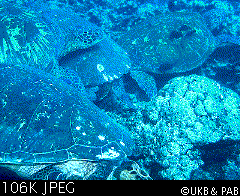
This 57% stat was interesting to us. Viral transmission is most successful when density of hosts is high. For this reason, we believe the site of disease transmission are the turtle houses, where animals spend much of their day sitting together--often touching, sometimes one atop another.
While we cannot extrapolate to other turtle sites on Maui or the Hawaiian Islands, we can comment on the Honokowai population. There, we notice that adult males do not congregate much with other turtles.
For the most part, the turtles we see are sociable and enjoy resting together. Juveniles like to cluster with older females. We can't tell females from males until the male's tail begins to grow, so we think of most smaller turtles as females. Over the years, we've watched some of these "females" turn into males.
When the tail starts to grow, the maturing male changes his behaviour. Where he once enjoyed the company of other turtles, he becomes reclusive, less tolerant of other turtles, and of course us.
We've seen Estrelita (the name shows that we originally considered this turtle was female), Nui, and 1993 Turtle 8D turn into males over the years. Estrelita and Nui in particular were friendly, confident turtles when we first met them. They would rest closely alongside other turtles.
Once the tails lengthened, they began to rest off on their own, in sight of other turtles but never as close as they did during their pre-sexual maturity years.
Zeus, 1991 Turtle 1, and 1991 Turtle 3 have always been males. We know that these three turtles also prefer resting by themselves away from others. Females, for whatever reason, enjoy clustering. Males seem less inclined to do so. When we see a group of 3-6 turtles all touching or piled one atop another, they are typically all females and juveniles.
Last year, we noticed a shift in the behaviour of Goofyfoot, a turtle we have known since 1992 and one we have been calling a female. Goofyfoot began behaving more aggressively, particularly to us. Even when we weren't in one of her resting spots, she would sometimes hover over us, prompting us to move. We would. Several times, when we were absorbed with photography, Goofyfoot sneaked up behind us and nipped our flippers. We would not be surprised if 1996 confirms Goofyfoot as an emergent male.
Are females more vulnerable? The social behaviour of the turtles of Honokowai would indicate so. They are the ones who cluster most. Males typically rest singly. If the contagion is spread through contact and proximity, the different behaviour of the sexes makes females more vulnerable.
One other interesting male/female difference we have noted: males seem to recover more readily. To date, we have seen four cases of regression. One is a tagged adult female, Tutu. Two others were Nui and Estrelita, both thought female until their tails grew. The regression occurred as they were undergoing sexual maturity. The other regression case is Goofyfoot, who we strongly believe will turn out to be male in 1996.
Should this prediction be true, 3 out of the 4 regression cases are males that have undergone sexual maturity. While this is a very small sample, it might indicate that not only are males behaviourally less vulnerable to the disease, once they get it, they fare better than the females as well.
As expected, in 1996 we confirmed that Goofyfoot is a male. We also confirmed that his regression is real. The last of his visible tumors had disappeared.
1996 also brought an interesting surprise: Hilu, another turtle that has shown signs of tumor regression, turned out to be male. Additionally, his tumors continued to regress. If this continues in 1997, Hilu will reinforce the regression pattern noted above.
Other 1996 observations complicate the picture, however. While we believe that our logic concerning the vulnerability of females and juveniles is sound, we feel obliged to point out that all of the Honokowai males we have observed, with a single exception, either had tumors or still have them. At Honokowai, therefore, fibropapilloma tumors seem to affect males, females, and juveniles indiscriminately.